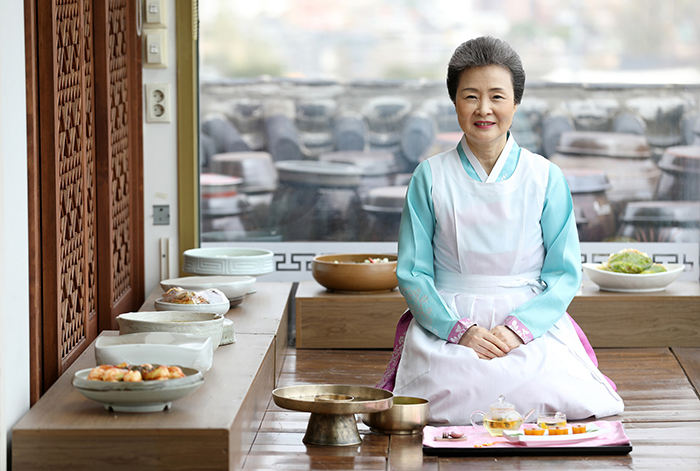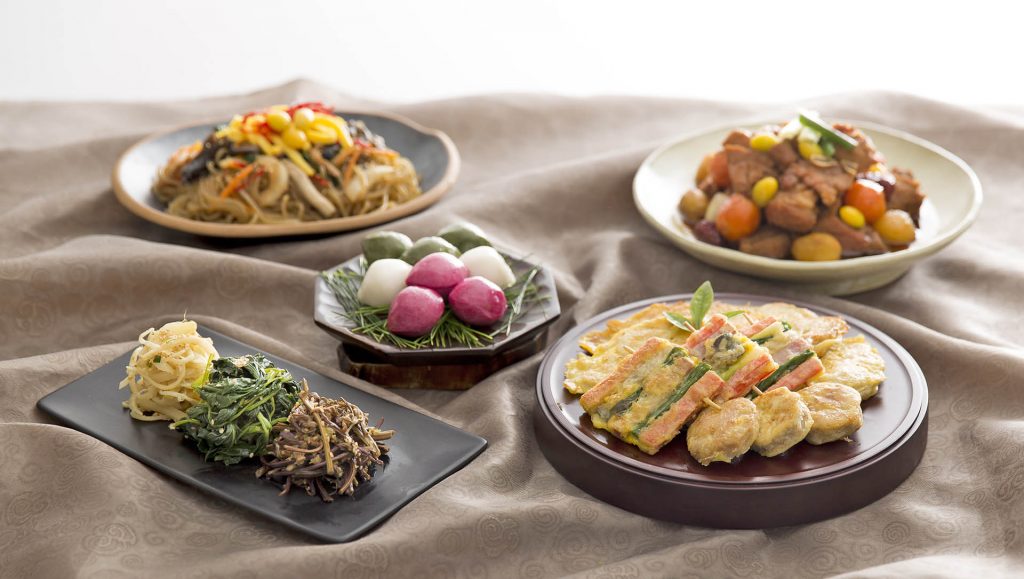
Bibimbap mixed rice with meat, and some greens with an eobok jaengban (어복쟁반) boiled meat platter.’ These are the menu items that Director Yoon Sook-ja of the Institute of Traditional Korean Food has recommended that the leaders of the two Koreas eat during their upcoming 2018 Inter-Korean Summit.
“This boiled meat platter is a North Korean dish. All the ingredients, including sliced and steamed meat, mushrooms and other vegetables, are placed in a large brass bowl and boiled together. You can enjoy it with soy sauce for dipping. Bibimbap is an iconic South Korean dish. All the different ingredients are mixed together so that you can share and enjoy it together and become one,” she explained.
Yoon was in charge of the reciprocal banquet on the southern side after the 2007 Inter-Korean Summit. She created a banquet called the “eight-province Daejangguem banquet,” named after the 2003-2004 hit TV soap opera “Jewel In the Palace” (대장금), which is called “Daejanggeum” in Korean.
Recalling the previous summit, Yoon said she has special feelings when she heard the news about the 2018 Inter-Korean Summit. She hopes that the leaders of the two Koreas can deepen their relationship and become closer, all while enjoying some food together.
The 2007 Inter-Korean Summit also gave her another meaningful memory, as she had the chance to see her hometown again, Gaeseong, which is in North Korea. Former President Roh Moo-hyun and his delegation drove from Seoul to Pyeongyang for the summit and passed through the North Korean border city.
“Everything seemed to be special when we passed the South-North Korea border check point in Dorasan and drove to Gaeseong. I was deeply moved when I realized that I was passing the spot where my ancestors lived and where I was born and raised. I was so excited with joy when I saw the school that my older sister and my aunt went to.”
The summit in Pyeongyang was followed by two banquets, one hosted by each side, to mark the historic gathering with all kinds of delicacies from across the peninsula.
Director Yoon said, “North Koreans used various ingredients, including poultry, meat and seafood, in a balanced manner in their dishes, such as steamed and cooled turkey, roast goose, a beef rib stew and a gray mullet soup with fish from the Daedonggang River. They tended to use less seasoning or toppings, and focused more on the genuine taste of the main ingredients.”
Regarding the menu on the South’s side, Yoon said, “We tried to use ingredients produced from all eight provinces, such as crab meat from Yeongdeok, abalone from Wando Island, black pork from Jeju Island, and beef from Hoengseong. We also used various seasonings and considered both the nutrition and the taste, to offer a balanced menu comprised of dishes made from ingredients from all across the country.”
Yoon said that the naengmyeon cold noodle from Ongnyugwan (옥류관) in Pyeongyang, the steamed and cooled turkey, and the roast goose were some of the most noticeable dishes in the North’s banquet, dishes which she would like to introduce to the South. She said that the cold noodles were served in two ways — the thicker noodles in a soybean sauce and the thinner noodles with some red pepper seasoning — and that both were delicious.
For steamed and cooled turkey and roast goose, she said the North used large poultry, which she found unique, as these are not commonly used in today’s South Korean cuisine.
Yoon hoped that the leaders of the two sides could become closer through food during the upcoming summit.
“Athletes from both Koreas participated in the PyeongChang 2018 Olympic and Paralympic Winter Games as one united team. I saw the North Korean art troupe perform in the South, which was followed by a South Korean art troupe performing in the North. They truly became one through the art performances. As the two sides became one through the arts like this, I hope that the two Koreas can become one through cuisine and our culinary traditions,” she said.
Source: Korea.net
